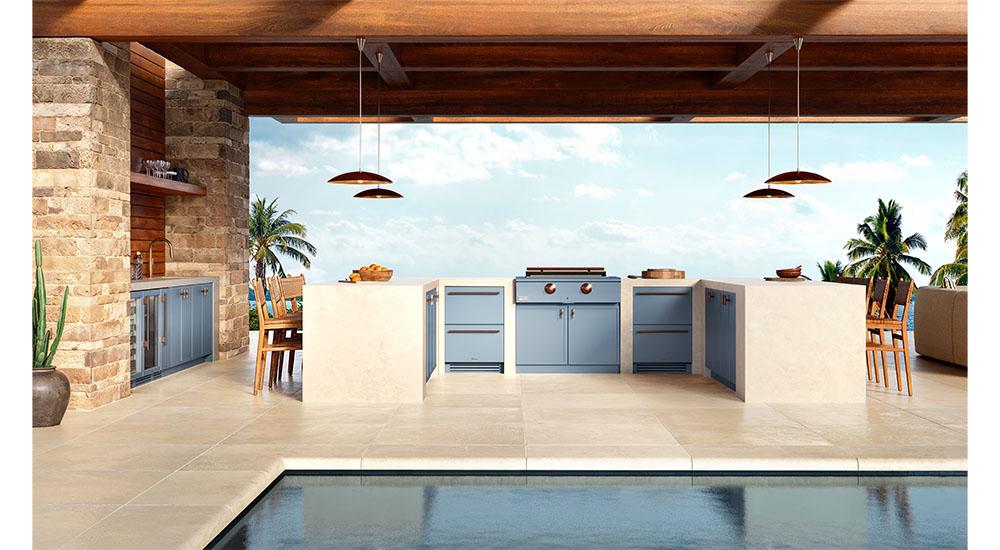If it’s not designed for entertaining, it’s not a great kitchen. With every new project, designers have the unique opportunity to create an environment that not only prioritizes style and functionality but invites meaningful connections, conversations, and joy. It is a noble pursuit. I truly (no pun intended) believe that thoughtfully designed spaces strengthen relationships and enhance our happiness.
The Link Between Good Design and Good Company
Today’s kitchens serve as modern-day hearths – where people gather for warmth, nourishment and human interaction. When a client expresses a love of hosting family and friends, it’s essential to think beyond the technical aspects of cabinetry or the traditional kitchen triangle. Instead, consider how spatial flow, appliances, lighting and layout can shape the experience – either drawing people in or, unintentionally, keeping them at a distance.
An island with comfortable bar seating naturally draws people in, offering them a prime view of the chef in action. Generous walkways around prep zones make it easy for multiple cooks or volunteer taste testers to partake without bumping elbows. Designers who approach projects from a relationship-first viewpoint often find that details such as strategically placed beverage centers, snack stations, or additional prep surfaces help cultivate a relaxed, inclusive atmosphere. When hosts and guests can pour a glass of wine or grab a quick bite without stepping away from the conversation – the space becomes more engaging – and everyone feels more at ease.
Indoor Kitchens: Zones That Encourage Gathering
A desirable setup for entertaining indoors often includes multiple distinct zones, each with its own function. While the classic work triangle is still valuable for cooking efficiency, layering additional areas – dedicated to prep, serving or gathering – can transform the space into a true hub for hosting.
Beverage Stations. Consider incorporating a dedicated beverage center with its own refrigeration, space for glassware, and possibly a small sink. This setup allows both hosts and guests to refresh their drinks without disrupting the cooking flow. Positioning this station near seating or in an adjacent lounge area keeps everyone connected—eliminating unnecessary breaks in conversation and enhancing the overall sense of ease and hospitality.
Dedicated Prep Zones. Whether it is a secondary island or a pullout cutting board, an additional prep zone offers guests a way to contribute without disrupting the flow Friends rarely arrive empty handed to a dinner party and having a dedicated space for their dish or helping hands makes them feel welcome rather than intrusive. Positioning it near primary cooking appliances but out of the chef’s immediate path prevents crowding.
Multi-Functional Islands. In an open-concept layout, the island often becomes a social anchor. By adding undercounter refrigerator drawers for quick and ergonomic access, built-in charging ports for electronics, and comfortable seating, the island can easily transition from a morning coffee station to an evening cocktail bar.
Outdoor Kitchens: Staying Where the Action Is
A modern luxury home is incomplete without a well-appointed outdoor space. An exterior kitchen provides a retreat and dramatically extends the home’s entertaining capabilities. The same guiding principle that applies indoors holds true outdoors as well: minimize the need to leave the area for routine tasks. The more self-sufficient the setup, the more likely hosts and guests are to stay present and connected.
Refrigerated Drawers and Beverage Centers. Nothing stalls the flow of conversation like having to run back inside for cold drinks or missing ingredients. Outdoor-rated refrigerator drawers or beverage centers make it possible to keep fresh produce and cold beverages within arm’s reach – right where the action is happening. This allows the host to remain present and engaged, rather than shuttling back and forth from the kitchen.
Cohesive Communal Cooking Area. Grills are the heart and soul of any outdoor kitchen – playing an integral role in the overall flow, functionality, and social dynamic of the space. A well-designed grilling station that encourages interaction and shared access invites guests to join in – transforming cooking into a communal experience. After all, grilling doesn’t have to be solo act; it can be a centerpiece of connection and camaraderie The Rockwell Social Grill by Caliber– a 360-degree, walk-around grill – illustrates this point to perfection. It’s outfitted with a fully retractable “disappearing lid” that allows for uninterrupted entertaining while grilling.
Ample Counter Space. Just as in the indoor kitchen, outdoor prep and plating areas require adequate surface space. Can the homeowner comfortably stage everything for grilling without risking cross-contamination where food is plated and served? Leaving space on either side of the grill helps ensure a clean, efficient workflow. Additionally, be sure to choose weather-resistant, durable countertop materials that can handle the elements while maintaining their visual appeal.
Protection from the Elements. A functional outdoor kitchen also benefits from some form of shelter, whether it is a pergola, canopy or extended roofline. Providing cover not only protects both people and appliances from harsh weather and direct sunlight but also allows gatherings to continue comfortably in a range of conditions. To extend usability across seasons, consider integrating fans, misters, heaters and discreet pest control solutions.
Flexible Seating. Outdoor entertainment thrives on versatility, and thoughtful seating zones play a key role. A casual bar area near the grill encourages relaxed conversation and spontaneous gatherings, while a formal dining table offers a setting for more structured meals. By incorporating multiple seating options, homeowners can effortlessly host everything from laid-back brunches off the griddle to leisurely dinner parties under the stars.
Intentionally Designing for Deeper Relationships
At the center of these recommendations is a simple goal: to foster meaningful interactions. When people can gather comfortably, share in the experience, and enjoy one another’s company, the kitchen becomes more than just a functional space – it becomes the setting for lasting memories. Designers can help achieve this by carefully anticipating how the space will be used, designers have the power to create environments that naturally invite and encourage easy social engagement.
Maximize Natural Flow. Foot traffic should bring people together not divide them. Seating and walkways should be arranged to invite conversation – positioning guests to face one another, rather than turning their backs on the moment. When flow supports interaction, the space feels more welcoming and alive.
Prioritize Comfort. Ergonomic counter heights, cushioned seating and thoughtfully layered lighting can make guests feel more relaxed. Small details, from cabinetry hardware to the right color palette, contribute to shaping an environment that feels warm, inviting and intentionally designed for gathering.
Embrace Personalization. Every client’s lifestyle and entertaining preferences are unique. Some dream of color-drenched spaces, while others envision a climate-controlled wine wall. By weaving in these personal touches, designers help homeowners truly shine as hosts, crafting spaces that reflect their style and celebrate social connection.
Designing kitchens for entertaining involves far more than floor plans; it’s about creating environments that nurture relationships and invite people to gather. Through additions like beverage centers and refrigerator drawers, multiple cooking and prep zones, and fully-equipped outdoor kitchens designed to entice people to stay in them, designers can shape spaces that serve as vibrant backdrops for connection, conversation and lasting joy.
—By Andrew Shead, national sales and marketing manager, True Residential









